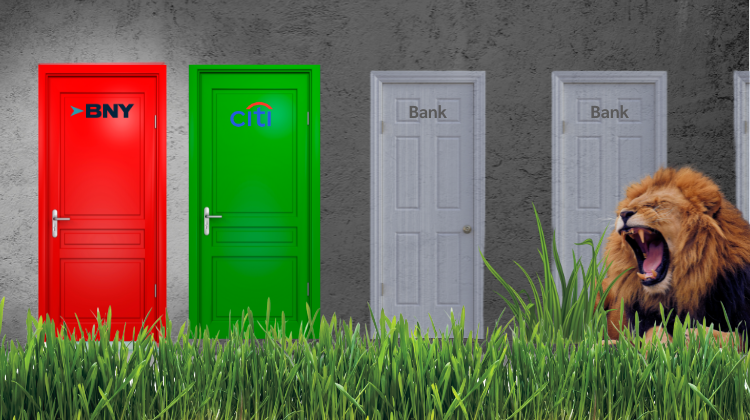Choosing the right bank to work with is a skill that fintechs need to develop and nurture. When the right choices are made, fintechs can find themselves working with banks that not only provide a strong compliance and banking layer but also have opportunities for the fintech to plug into the bank’s infrastructure and become more than just a client.
This evolving landscape is what Citi’s Global Head of Fintech Sales, Chafic Haddad, provided insight on when I spoke to him. He dove into the maturity cycle that fintechs go through by starting from offering basic products like accounts and then eventually growing enough to explore capital markets and investment banking. He also described how Citi helps these fintechs spread their wings beyond their local markets.
Listen to today’s conversation to learn from Haddad’s experience about how the bank helps fintechs grow sustainably and eventually spread their wings beyond their local geographies and the way Citi organizes and manages these relationships.
Big ideas
Chafic’s role: My team’s job is to provide or connect fintechs with what we do within the transaction bank. We’re the business that manages the overall relationship across all Citi products. We have a two fold structure: you’ve got the commercial bank, which would typically look after small to medium sized fintechs, and then the more mature unicorn type fintech would sit within our banking organization.
How Citi chooses which fintechs to work with: We consider a range of factors including growth potential. We have finite resources. We can’t take on everybody and it’s a space that continues to grow and evolve. Growth is key, because we want to be working with entities that have ambitions. Given our network, we’d like to be partnering with fintechs that want to grow beyond their home market.
How Citi’s fintech relationships begin: We want this to be a long term relationship, at a minimum of 5-10 years or even longer. Initially, the entry point is the business that I represent, which is the transaction banking business, or the Citi Treasury and Trade Solutions (TTS) because that is the go to area for any fintech on day one. They want accounts, access to payment schemes, and treasury management.
How Citi collaborates with fintech clients: They [fintech CEOs] have a vested interest in being part of the strategic discussion to work with Citi. This is ultimately their business and their name on the door. Those conversations take place at multiple levels, often starting at the top of the house, and then once we focus or zoom in.
Evolving relationships: Many start off as clients and we collaborate and co-create. But in several cases, they actually come into our ecosystem as providers of service and become clients over time.
Listen to the podcast
Subscribe: Apple Podcasts I SoundCloud I Spotify
The full transcript
Building on legacy
Whether you play in the merchant acquiring space as a fintech, or you offer domestic cross border solutions or drive FX (foreign exchange) platforms, you need a provider that can give you access to payment channels and schemes, support you with operating accounts, help you manage liquidity, and help you manage and safeguard client monies. And to do all of that while guiding you through the regulatory environment.
So I would say those are the two or three things that stand out for me in terms of what a fintech really needs from a provider or a banking institution. As a 200 year plus financial institution with international branches in over 90 countries, we believe that we are well-placed to support fintechs, whether they are domestically focused or looking to offer their solutions globally. We’re leveraging our long history as a provider of financial services as well as our global presence to roll out solutions to prioritize a digital, 24/7 approach to payments; advancing the client experience and ensuring liquidity for our clients around the clock.
Our network is unique. We have the largest network today compared to other large multinational banks, and that is something that really appeals to our clients, because it underlines our commitment to the international arena.
When you deal with Citi, you’re effectively dealing with the institution that’s plugging you into one platform. The model is similar wherever you do business in New York, London, Tokyo or Sydney. The products and solutions are more or less the same.
I say ‘more or less’ because there are some differences that are driven by local regulation, but effectively, we can be your one stop shop. As far as a global strategy is concerned, we talked about how Citi supports fintechs around the world, but there is also collaboration or co-creation that Citi has entered into with a number of fintechs to come up with solutions that are now offered as mainstream.
One example of that is our Pay-to-China offering. If you think about Chinese merchants that are selling online overseas, one of their challenges is collecting funds. So the Pay-to-China offering at Citi enables offshore payment intermediaries to pay directly into their merchant’s local currency bank accounts in China for goods that have been sold online or overseas through e-commerce platforms. It’s a solution that leverages our FX capabilities and access to domestic payment schemes in China to provide a seamless cross border payment experience.
Another example is our Spring by Citi® offering, which is our acquiring engine and digital payment acceptance solution. It’s also an example of how we’re collaborating and co-creating with ecosystem fintech partners to roll out this offering in multiple markets.
One more example is Citi® Payments Express, which is our 24/7 cloud-enabled digital commerce solution. It’s a solution that facilitates multi-domestic and real time liquidity and gives us the opportunity to scale to 100 times the volume while operating at much lower costs. We’re looking to roll out Express in the top global markets in the next few years.
Fintech priorities: Growing beyond local borders
Fintech entities that we’ve been in business with for a number of years are now looking to grow, – if they haven’t already done so – beyond their home market. That is typically driven by both a need to support existing customers who are doing business in multiple markets, as well as opportunities to acquire new ones.
The other interesting dynamic is that many set out to offer a single product. We will be your FX partner and we will help you acquire if you’re selling in marketplaces. Now we’re seeing those same entities develop and sell more than one solution. In order for them to expand their product offering, some have even gone as far as acquiring banking licenses, and that has allowed them to get into the deposit-taking space and lending space, as well as do other regulatory-focused products.
On working with Citi
So one thing that we’re very keen on is we don’t simply want to be a provider of service. That is something that typically kickstarts the relationship. But over time, we want to co-create with the fintech clients that we do business with. That means we sit together, understand what their strategic objectives are, how they envision their strategy to be over the next three to five years, and then work with them in building the products and solutions to get them there.
We typically connect at various levels of the organization. Unlike some other sectors, you’ll find that in the fintech space, a lot of the CEOs are owners and operators. They have a vested interest in being part of the strategic discussion. This is ultimately their business and their name on the door. Those conversations take place at multiple levels, often starting at the top of the house, and then once we focus or zoom in on an idea or an innovative solution, that gets focused with the people at various levels.
What’s interesting about our relationships with fintechs is they’re quite dynamic. Many start off as clients and we collaborate and co-create. But in several cases, they actually come into our ecosystem as providers of service and become clients over time. It’s a dynamic space. There are opportunities for us to plug into one another’s capabilities.
One example of that is we have a cross currency crossborder platform called Worldlink. Even though we are present in over 90 countries, there are some markets where we are not physically on the ground for one reason or another. So in those instances, we need to find a partner that we can connect with and collaborate with to help us deliver our service on the ground – and those are the kinds of collaborations that take place with some of the fintech clients.
We’re quite deliberate about the fintechs we choose to take on as clients. We consider a range of factors including growth potential. We have finite resources, as you can appreciate. We can’t take on everybody and it’s a space that continues to grow and evolve. Growth is key, because we want to be working with entities that have ambitions. Given our network, we’d like to be partnering with fintechs that want to grow beyond their home market, as I mentioned earlier, and actually have longer term objectives. For us, these relationships are difficult to establish. The onboarding process is rigorous. It requires quite a lot of heavy lifting.
So once we get over that, we want this to be a long term relationship, at a minimum 5-10 years or even longer. Initially, the entry point is the business that I represent, which is the transaction banking business, or the Citi Treasury and Trade Solutions (TTS) because that is the go to area for any fintech on day one: we want accounts, we want access to payment schemes, and we want treasury management.
We want help collecting once we plug them into these solutions and we then evolve the conversation into other areas, whether it’s around capital markets or broader investment banking or working capital.
Citi’s evolution to work with fintechs
The capabilities within our network continue to evolve, as we roll out new solutions, and we’re doing that all the time. The ultimate aim is to be able to do that across the network to give you that seamless experience wherever you’re doing business with Citi. That is something that continues to be at the heart of everything that we do. Given the geographic reach that we have, we have expertise at the ground level to guide our fintech clients through the regulatory challenges, local laws, regulations, what to expect and how to go about licensing. That puts us in a unique position. We also have an experienced and dedicated fintech sales team – my role, and that of my teams, is focused exclusively on the fintech segment.
We don’t talk to anybody else from a client segmentation perspective, unless they fall into our fintech definition. Hence, you’ve got that expertise on the team, that network that allows you to operate globally, and you’ve got the local expertise on the ground. I’d also add that over time, we’ve become a trusted advisor to our clients, so our deep rooted industry expertise enables us to guide our fintech clients as they seek new opportunities, new customer segments and look to grow.
Navigating timezones as a professional
Geography does not matter much when you’re in a global role, because I’m constantly on the road. From a timezone perspective, it works for me, because it gives me a good half day with Asia in the morning, and then as the day goes on, Europe and the UK come online. And then my afternoons and evenings are with the U.S.. So it works from that perspective.
The way we’re organized is that I have regionals, and they’re located in New York, Miami – which is our Latin Hub – Hong Kong, and Dublin, which is our service European hub. They have individuals that report to their own teams and all of that is part of a wider team which supports our fintech clients and goes out and positions what we do best at Citi to those clients.
Citi’s organizational structure
I sit within the product organization. We also have side by side coverage organizations – what we at Citi call corporate banking – as well as our commercial bank. Commercial banking tends to be the entry point for a relatively new-to-market fintech: these are firms that have been operating for a couple of years, they’re low turnover, but have a good runway ahead of them.
My team’s job is to provide or connect fintechs with what we do within the transaction bank –the business that manages the overall relationship across all products. Citi also hast the commercial bank, which would typically look after small to medium sized fintechs, and then the more mature unicorn type fintech would sit within our banking organization.
I typically would service the fintechs that are more complex and have had several years of history under their belt, that are now at a stage where they have either expanded internationally or are continuing to expand internationally. That’s not to suggest that we don’t connect with our partners on the commercial bank, because what they’re looking after are fintechs at an early stage. But that early stage quickly becomes a later stage, and then there are opportunities for my team to plug into their strategy and provide them with the solutions they’re looking for to continue their growth.
Disclaimer: The views and opinions expressed by the individual, unless reflected in Citi’s Research Reports, are those of the speaker and may not necessarily reflect the views of Citi or any of its affiliates. All opinions are made at the time of the recording and are subject to change without notice. The expressions of opinion are not intended to be a forecast of future events or a guarantee of future results.










